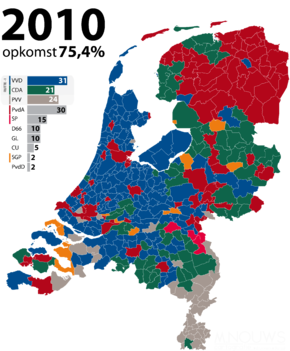
Back Eleccions legislatives neerlandeses de 2010 Catalan Parlamentní volby v Nizozemsku 2010 Czech Parlamentswahl in den Niederlanden 2010 German Ολλανδικές γενικές εκλογές 2010 Greek Elecciones generales de los Países Bajos de 2010 Spanish Alankomaiden parlamenttivaalit 2010 Finnish Élections législatives néerlandaises de 2010 French Elezioni legislative nei Paesi Bassi del 2010 Italian Tweede Kamerverkiezingen 2010 Dutch Parlamentsvalget i Nederland 2010 NB
You can help expand this article with text translated from the corresponding article in Dutch. (June 2010) Click [show] for important translation instructions.
|
This article's lead section contains information that is not included elsewhere in the article. (September 2022) |
| |||||||||||||||||||||||||||||||||||||||||||||||||||||||||||||
All 150 seats in the House of Representatives 76 seats needed for a majority | |||||||||||||||||||||||||||||||||||||||||||||||||||||||||||||
| Turnout | 75.40% ( | ||||||||||||||||||||||||||||||||||||||||||||||||||||||||||||
|---|---|---|---|---|---|---|---|---|---|---|---|---|---|---|---|---|---|---|---|---|---|---|---|---|---|---|---|---|---|---|---|---|---|---|---|---|---|---|---|---|---|---|---|---|---|---|---|---|---|---|---|---|---|---|---|---|---|---|---|---|---|
This lists parties that won seats. See the complete results below.
| |||||||||||||||||||||||||||||||||||||||||||||||||||||||||||||
General elections were held in the Netherlands on Wednesday 9 June 2010. This was triggered by the fall of Prime Minister Jan Peter Balkenende's fourth cabinet on 20 February with Queen Beatrix accepting the resignation of the Labour Party (PvdA) ministers on 23 February.[1] The conservative-liberal People's Party for Freedom and Democracy (VVD), led by Mark Rutte, won the largest number of seats in the House of Representatives while the social-democratic PvdA, led by Job Cohen, came a narrow second. The election was also noted for the rise of the Party for Freedom (PVV), which came third, led by controversial politician Geert Wilders. On the other hand, Balkenende's Christian Democratic Appeal (CDA) saw a poor result, losing half its seats (along with popular support) and dropping from first to fourth place. The Socialist Party (SP) also lost seats. Notably, the 31 seats won by the VVD was its most since 1998, and the one-seat margin between the VVD and PvdA is the closest on record.[2]
After the election, the formation of a new government took 127 days. Both the VVD and the PvdA hoped to have a leading role. VVD talks with the PvdA and other left-wing parties (trying to form a so-called Purple Coalition without Christian parties) broke down; however, Rutte was able to form a right-wing coalition of the VVD and CDA, with the PVV formally making an agreement (gedoogakkoord) to support the government but without holding any cabinet seats. It was the first coalition government not to be led by a Christian democratic or socialist party in 92 years, as well as the first to be led by the VVD. Rutte was sworn in as Prime Minister on 14 October, becoming the first liberal to hold that post since 1918.
The 150 seats of the House of Representatives (Tweede Kamer der Staten-Generaal) were contested, and were filled using party-list proportional representation for a nominal four-year term.
- ^ "Ontslag en benoeming bewindspersonen" (in Dutch). Rijksvoorlichtingsdienst. 2009-02-23. Retrieved 2009-02-23.
- ^ "Election 2010 – The Netherlands shifts to the right". nrc.nl. 10 June 2010. Archived from the original on 2010-06-13. Retrieved 10 June 2010.
© MMXXIII Rich X Search. We shall prevail. All rights reserved. Rich X Search
